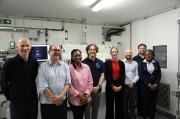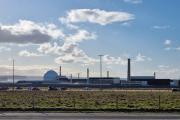Dounreay Visitor Centre Will Not Open In 2007
9th March 2007
OUT WITH THE OLD AND IN WITH THE NEW
Old age and severe weather have taken their toll on the seasonal visitor centre at Dounreay. The former World War Two air traffic control tower was damaged during
severe flooding in November.
Further deterioration in its condition over the winter months has led to its closure being brought forward.
Dounreay will now concentrate on providing a new exhibition about the site decommissioning as part of a multi-million pound visitor development in Thurso.
In 2002, when UKAEA looked at options for modernising the visitor centre, the existing facility overlooking the site was deemed beyond economic repair. The cost then was estimated to be �500,000. At the same time, the Highland Council was looking for support for a major new community and visitor attraction planned for Thurso and Dounreay gave �500,000 towards the cost of this instead.
Caithness Horizons is scheduled to open in 2008, and the existing centre was patched up to keep it running until the end of the 2007 summer season. But the building - hurriedly erected almost 70 years ago when Dounreay became a naval aerodrome - has deteriorated significantly over the winter. The money saved by bringing forward its closure will be reallocated to decommissioning work at the site.
"The guides who staffed the facility each summer did an excellent job for the site and I am sorry we won't be able to provide them with one last season of work," said Colin Punler, site communications manager.
"But there comes a point in the life of any building when it doesn't make sense to invest more money and sadly we have now reached that the point with the old control tower. The nett effect on employment should be neutral, however, because the money will be used to sustain decommissioning work instead.
"Although the fast reactor experiment is over and the site now in the throes of demolition, it is important the site keeps open the channels of communication. The closure of the visitor centre leaves a gap in those communications, so the site is now looking at relocating off-site some other aspect of its communications."
For the new centre to open in 2008 see
Caithness Horizons
http://www.caithness-business.co.uk/business.php?id=1193
Related Businesses
Related Articles
UKAEA develops 3D printing for fusion components
At its recently opened Central Support Facility (CSF), UKAEA has commissioned an electron beam additive manufacturing machine that can be used to incorporate tungsten into components, alongside a selective laser manufacturing machine. Fusion can play a key role in a global low carbon energy future.Advancing Fusion Remote Maintenance: Industry Collaboration Driving Innovation
As part of the Fusion Futures (FF) programme, UKAEA's Remote Applications in Challenging Environments (RACE) has partnered with industry leaders to develop two groundbreaking technologies for remote maintenance in fusion energy engineering. Thanks to FF funding, industry has taken the lead in maturing UKAEA technology concepts—delivering real-world solutions that enhance operational autonomy and reduce maintenance burdens in extreme environments.UKAEA launches International Fellowships Scheme for fusion
UKAEA has launched the International Fellowships Scheme, an initiative to help expand the global talent pool supporting the fusion industry. The scheme is part of the UKAEA's Fusion Opportunities in Skills, Training, Education and Research (FOSTER) Programme, which aims to train, support, and empower the next generation of professionals, who will help deliver fusion power to the grid.Kyoto Fusioneering and Astral Systems join Culham fusion hub
UKAEA's Culham Campus welcomes Kyoto Fusioneering and Astral Systems as its latest tenants. Two pioneering companies, Kyoto Fusioneering and Astral Systems, have joined the growing cluster of fusion technology and AI organisations at United Kingdom Atomic Energy Authority's (UKAEA) Culham Campus.
Fusion-grade Steel Produced At Scale In UK-first
Researchers achieve 10x production cost savings for reduced activation steel. A United Kingdom Atomic Energy Authority (UKAEA) working group has successfully demonstrated the industrial scale production of fusion-grade steel.
UKAEA To Lead The Creation Of A Robotics And AI Cluster
UKAEA will lead the creation of a new £4.9m nuclear robotics and artificial intelligence cluster across Cumbria and Oxfordshire. The robotics and AI cluster was announced by UK Research and Innovation (UKRI) as one of seven new projects to kickstart economic growth and address regional needs: www.ukri.org The robotics and AI cluster will link Cumbria and Oxfordshire to accelerate the decommissioning of the UK's legacy nuclear fission facilities and keep people out of hazardous environments.
Diamonds Are Forever? World-first Carbon-14 Diamond Battery Made In Uk
The world's first carbon-14 diamond has been produced with the potential to provide power for thousands of years. Scientists and engineers from the UK Atomic Energy Authority (UKAEA) and the University of Bristol have successfully created the world's first carbon-14 diamond battery.
UKAEA Monthly Newsletter Latest Edition
Find out what has been happening at UKAEA in our monthly newsletter. Read about our recent activities and upcoming events.
UKAEA Newsletter - Edition 11 Published Today
Find out what has been happening at UKAEA in our monthly newsletter. Read about our recent activities and upcoming events.
Corwm Visits Dounreay Nuclear Site
Members were given an overview of the scale of the problem and challenges faced in the decommissioning of the site. In the last week of March 2024, several members of CoRWM led by the Chair, Sir Nigel Thrift, made the long journey up to the North of Scotland to visit the Dounreay nuclear site, now managed by Nuclear Restoration Services.
